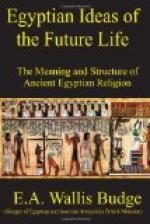In the interval which elapsed between the period of the prehistoric burials and the IVth dynasty, the Egyptian formulated certain theories about the component parts of his own body, and we must consider these briefly before we can describe the form in which the dead were believed to rise. The physical body of a man was called KHAT, a word which indicates something in which decay is inherent; it was this which was buried in the tomb after mummification, and its preservation from destruction of every kind was the object of all amulets, magical ceremonies, prayers, and formulae, from the earliest to the latest times. The god Osiris even possessed such a body, and its various members were preserved as relics in several shrines in Egypt. Attached to the body in some remarkable way was the KA, or “double,” of a man; it may be defined as an abstract individuality or personality which was endowed with all his characteristic attributes, and it possessed an absolutely independent existence. It was free to move from place to place upon earth at will, and it could enter heaven and hold converse with the gods. The offerings made in, the tombs at all periods were intended for the nourishment of the KA, and it was supposed to be able to eat and drink and to enjoy the odour of incense. In the earliest times a certain portion of the tomb was set apart for the use of the KA, and the religious organization of the period ordered that a class of priests should perform ceremonies and recite prayers at stated seasons for the benefit of the KA in the KA chapel; these men were known as “KA priests.” In the period when the pyramids were built it was firmly believed that the deceased, in some form, was able to be purified, and to sit down and to eat bread with it “unceasingly and for ever;” and the KA who was not supplied with a sufficiency of food in the shape of offerings of bread, cakes, flowers, fruit, wine, ale, and the like, was in serious danger of starvation.




